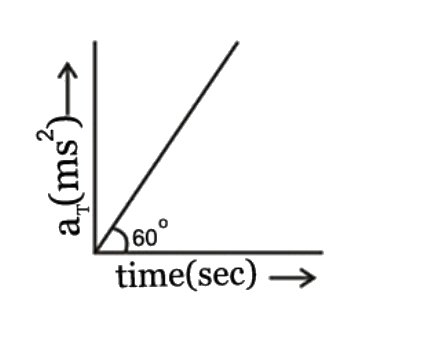In a circular motion of a particle the tangential acceleration of the particle is given by a1=2m/s2. The radius of the circle described is 4 m. The particle is initially at rest. Time after which total acceleration of the particle makes 45∘ with radial acceleration is :
1 sec
2 sec
3 sec
4 sec
The correct Answer is:B
To solve the problem step by step, we can follow these steps:
Step 1: Understand the Given Information
- Tangential acceleration, at=2m/s2
- Radius of the circular path, r=4m
- Initial velocity, u=0m/s
Step 2: Determine the Condition for 45 Degrees
For the total acceleration a to make an angle of 45∘ with the radial acceleration ac, the magnitudes of the tangential acceleration at and centripetal acceleration ac must be equal:
at=ac
Step 3: Express Centripetal Acceleration
Centripetal acceleration is given by:
ac=v2r
where v is the linear velocity of the particle.
Step 4: Set Up the Equation
From the condition at=ac:
2=v24
Step 5: Solve for Velocity v
Rearranging the equation gives:
v2=2×4=8
v=√8=2√2m/s
Step 6: Use the Equation of Motion to Find Time
We will use the equation of motion to find the time t:
v=u+at⋅t
Substituting the known values:
2√2=0+2⋅t
t=2√22=√2s
Final Answer
The time after which the total acceleration of the particle makes 45∘ with the radial acceleration is:
√2s
- Tangential acceleration, at=2m/s2
- Radius of the circular path, r=4m
- Initial velocity, u=0m/s
For the total acceleration a to make an angle of 45∘ with the radial acceleration ac, the magnitudes of the tangential acceleration at and centripetal acceleration ac must be equal:
at=ac
Centripetal acceleration is given by:
ac=v2r
where v is the linear velocity of the particle.
From the condition at=ac:
2=v24
Rearranging the equation gives:
v2=2×4=8
v=√8=2√2m/s
We will use the equation of motion to find the time t:
v=u+at⋅t
Substituting the known values:
2√2=0+2⋅t
t=2√22=√2s
The time after which the total acceleration of the particle makes 45∘ with the radial acceleration is:
√2s
Similar Questions
In a circular motion of a particle , the tangential acceleration of the particle is given by at=9ms−2 . The radius of the circle is 4m . The particle was initially at rest. Time after which total acceleration of the particle makes an angle of 45∘ with the radial acceleration is
View SolutionTangental acceleration of a particle moving in a circle of radius 1 m varies with time t as shown in figure (initial velocity of the particle is zero). Time after which total acceleration of particle makes an angle of 30∘ with radial acceleration is

View SolutionStarting from rest, the acceleration of a particle is a=2(t-1). The velocity of the particle at t=5s is :-
View SolutionThe velocity time relation of a particle is given by v =(3t2−2t−1)m/s Calculate the position and acceleration of the particle when velocity of the particle is zero . Given the initial position of the particle is 5m .
View SolutionIf a particle moves in a circle of radius of 4m at speed given by v=2t where v is in m/s and t in sec.At t=4s ,net accleration of particle will be:
View SolutionIs the acceleration of particle in uniform circular motion constant or vartiable?
View SolutionIn a non - uniform circular motaion the ratio of tangential to radial acceleration is (where, r= radius of circle, v= speed of the particle, α= angular acceleration)
View SolutionInitial velocity and acceleration of a particles are as shown in the figure. Acceleration vector of particle remain constant. Then radius of curvature of path of particle :

View SolutionVelocity of a particle is given as v=(2t2−3)m/s. The acceleration of particle at t = 3s will be :
View SolutionA particle starts from rest and moves with an acceleration of a={2+|t−2|}m/s2 The velocity of the particle at t=4 sec is
View Solution
